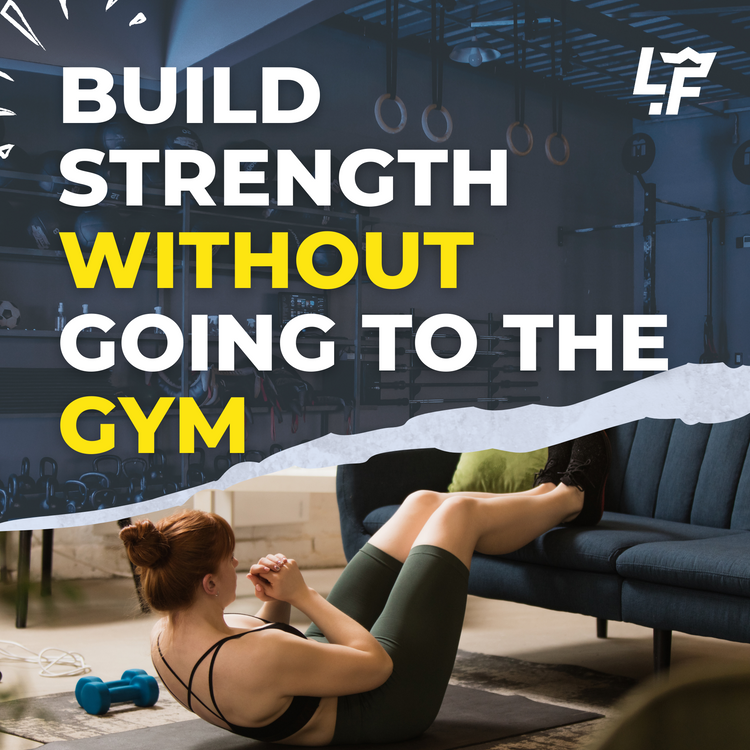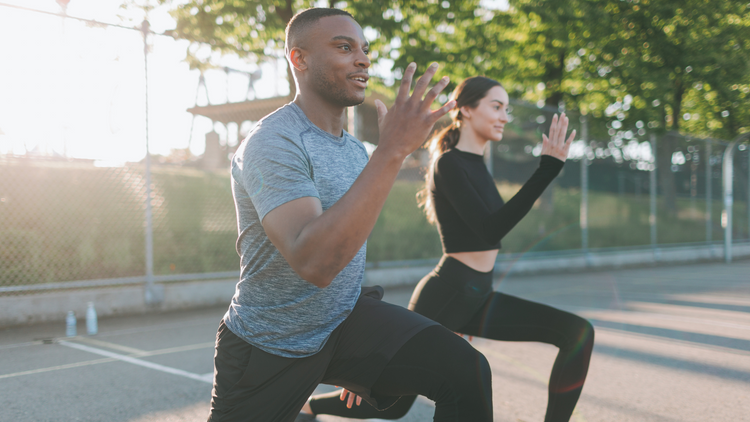Full-Body Strength Training at Home

Getting solid and fit meant heading to the gym and moving heavy weights around. But what if you don't have access to barbells and machines? What if the thought of grunting powerlifters and crowded cardio areas keeps you away? You might assume it's impossible to build serious strength at home with effective strength training.
But that assumption would be dead wrong.
Enter the resistance band - your ticket to sculpting all-over strength with minimal equipment and maximum convenience. Specifically, vertical pull-up bands open a world of practical bodyweight training beyond the standard push-ups and squats, making resistance band workouts a versatile option for many.
These stretchy bands take pull-up bars to the next level, providing just enough assistance for you to perform vertical pulling motions that might otherwise be impossible. Vertical pulls are essential for building resilient shoulders, prominent biceps and lats, a sturdy core, and functional fitness that transfers well to real life.
If you're ready to construct a station for pull-up chinning at home, keep reading. We'll explore eight phenomenal band-assisted exercises for mastering fitness from head to toe.
What Exactly Are Pull-Up Bands?
Pull-up bands are large elastic bands with handles on each end, designed to be anchored overhead on any high bar or beam. By stepping into the loops or holding the handles, you can apply vertical resistance equivalent to 10-100 extra pounds of assistance, allowing you to perform pull-up patterns with proper form. These bands are integral to resistance band exercises, providing an accessible entry point for resistance training.
Use lighter bands or remove them as you become stronger over time. Pull-up bands are an accessible entry point for building foundational pulling strength using your body weight - no gym required!
Why Prioritize Vertical Pulls at All?
Most of us have pushing strength locked in. We press benches, shoulder presses, and push-ups galore. But rarely do we emphasize the opposing pull-up patterns that develop back strength for posture and injury resilience. Without them, you drift into imbalance, instability, and injury.
Further, a thick, muscular back is the foundation of any impressive physique. Even if aesthetic appeal isn't your goal, you likely want to avoid the hunched profile from neglected pull muscles.
Combining vertical pulls with standard push-up patterns gives you the perfect blend of well-rounded functional capacity and an enviable v-taper. The only catch? Pull-ups are challenging, especially for beginners.
But bands change everything, delivering the boost you need to perform vertical pulls correctly and build strength rapidly until you can pull your chin over the bar under your power - an immensely gratifying milestone!
Eight Total Body Pull-Up Band Exercises For Full Fitness
The following exercises utilize pull-up assist bands to challenge your strength, stability, and mobility in planes you rarely address. Moving vertically against gravity is a fundamentally different stimulus than horizontal gym training. This full body resistance band workout results in newfound functional competence that carries over beautifully into everyday movement.
Make it a point to explore all eight patterns for a comprehensive approach. As you'll see, combining bands with bodyweight pulls is an enormously efficient way to build fitness precisely tailored to the demands of real life.
Assisted Pull Ups
What are Assisted Pull-Ups?
The classic vertical pull originates from a dead hang to pull your chin over the bar using assistance from anchored bands, miming the natural pattern of climbing motions.
Why do Assisted Pull-Ups?
Progressive overload on this movement pattern builds tremendous grip, arm, scapular, and core strength. It's one of the most comprehensive and functional exercises you can perform. Master it, and real-world strength tasks become much more manageable.
How to do Assisted Pull-Ups?
- Anchor pull-up bands overhead on any sturdy bar.
- Step into the foot loops, maintaining tension on the band.
- Initiate the pull by depressing and retracting your shoulder blades, then continue pulling your elbows down and back until your chin passes over the bar.
- Eccentrically lower with control.
Muscles Activated?
Lats, biceps, rear & side deltoids, rotator cuff muscles, shoulder & core stabilizers.
Straight Arm Pulldowns
What are Straight-Arm Pulldowns?
Keeping arms straight, pull handles from overhead down along the front of your body by hinging at the shoulder and engaging back muscles.
Why do Straight-Arm Pulldowns?
The simple reason is that pulldowns promote scapular stability with arms fixed straight. Challenges numerous smaller stabilizers as a single arm variation.
How do you do Straight-Arm Pulldowns?
- Take a staggered stance standing below-anchored bands.
- Maintain rigid, straight arms throughout motion so that back and shoulders do all the work, pulling handles down from overhead to hips.
- Squeeze lats to bring handles together at the finish.
What muscles do Straight-Arm Pulldowns activate?
Lats, rear deltoids, rotator cuff muscles, scapular stabilizers.
Band-Assisted Bicep Curls
What are Band-Assisted Bicep Curls?
Take hold of the handles of anchored pull-up bands and perform concentric-only bicep curls, primarily working the elbow flexors. Eccentrically lower slowly with control.
Why do Band-Assisted Bicep Curls?
Direct arm focus combines excellently with vertical pull patterns to build chiseled, functional, peaked biceps. The assistance bands provide a more significant load compared to free bodyweight curls.
How to do Band-Assisted Bicep Curls?
- Stand below anchored handles gripping band connection point.
- Keeping upper arms fixed by your sides, initiate the curl by flexing elbows and pulling handles toward shoulders until palms nearly face forward.
- Emphasize sustained contraction before slowly lowering back to start.
Muscles Activated?
Biceps brachii, brachialis, brachioradialis.
Standing Resistance Band Rows
What are Standing Resistance Band Rows?
Pulling horizontal rows with anchored bands to mimic lat pulldown machines. Using the postural triple extension, Standing Resistance Band Rows build tremendous strength in mid-back muscles.
Why Do Standing Resistance Band Rows?
Heavy mid-back recruitment transfers pull strength gains into everyday hinging and carrying capacity. It promotes rear shoulder stability and opens up the thoracic spine, critical for respiration.
How to do Standing Resistance Band Rows?
- Begin hinged forward at hips with tension on anchored band handles.
- Maintain a flat-back posture. Initiate pull by driving elbows back towards hips, leading with the elbows.
- Pause and squeeze shoulder blades together before slowly and eccentrically lowering them under control.
Muscles Activated?
Lats, mid & low traps, rear deltoids, rotator cuff muscles, erector spinae.
Triceps Pushdowns
What are Triceps Pushdowns?
The standing pushdown pattern works the back of the arm - elbows extend overhead, stretching the long head of the triceps and descending behind the head.
Why do Triceps Pushdowns?
Balance pushing the capacity of the anterior arm - combines perfectly with pull patterns using the same anchored bands. It builds arm definition and straight arm stability.
How to do Triceps Pushdowns?
- Stand below anchored handles.
- Initiate motion by fully straightening arms overhead, joint stacked with cable.
- Only bend your arms at the very end of the motion to maximize triceps stretch.
- Return slowly with elbows tight to the sides.
Muscles Activated?
Triceps - long, lateral, and medial heads, anconeus.
Upright Rows
What are Upright Rows?
Initiate row pull from arms extended along thighs, leading with elbows lifting towards the chin, working shoulder muscles dynamically.
Why do Upright Rows?
Builds tremendous shoulder and trap definition enhances scapular mobility strength critical for injury resilience. Additionally, it complements horizontal pull patterns.
How to do Upright Rows?
- Standing with tension on anchored band handles, ensure a locked core, flat back, and soft knees.
- Drive elbows directly towards the chin, pulling shoulder blades down and back at the top.
- Control return without letting shoulders rounded forward.
Muscles Activated?
Lateral deltoids, upper traps, levator scapula, rotator cuff muscles.
Pull Throughs
What are Pull-Throughs?
Powerful hip hinge pattern builds tremendous posterior chain strength - glutes, hamstrings, and spinal erectors.
Why do Pull-Throughs?
Perfect posture compliments targeting the back side of the body to balance pressing and pulling capacity. Pull-throughs enhance athletic power for acceleration and explosive efforts.
How to do Pull-Throughs?
- Anchor band low to rig or support.
- Step through handles and place tension on the hips and hamstrings.
- Maintain a flat back, and initiate pull-through by driving hips back then forwards until upright. Squeeze glutes to finish.
Muscles Activated?
Glutes, hamstrings, erector spinae.
Sample Beginner Band Pull-Up Workout Routine
Having explored the breadth of movement patterns possible with a pull-up rig and bands, let's outline a balanced total body beginner workout. This routine is perfect for those looking to start resistance band workouts for beginners:
Warm Up
- 5 minutes of light cardio of choice
Pull-Up Band Workout
- Three sets of Assisted Pull-Ups
- Three sets of Banded Standing Rows
- Three sets of Triceps Pushdowns
- Three sets of Banded Bicep Curls
- Three sets Front Raise & Pulldown Combo
- Three sets of Pull-Throughs
The Workout Breakdown
We begin with a simple warmup to elevate heart rate and prep for activity. Move straight into three extensive vertical pull compound exercises focusing on the back and arms. Balance the push and pull with isolated arm work, anterior shoulders, and posterior chain hip power.
Aim to progress each movement independently by decreasing band assistance over time. The first goal is to establish exercise competency and practice. By keeping the volume relatively low to start, we focus on quality over quantity with attention to form and control.
That's all it takes to assemble a comprehensive fitness flow using pull-up bands as your springboard to newfound strength!
Conclusion
Mastering fitness with total body pull-up band exercises is more than a trend; it's a transformative approach to holistic well-being. The versatility and efficiency of pull-up bands make them an invaluable addition to any fitness routine. By understanding the types of bands, embracing total body workouts, and incorporating the eight exercises outlined in this guide, you're on the path to a more robust, fitter, and healthier you.
Additional Tips
- Ensure proper form in each exercise to maximize effectiveness and prevent injuries.
- Gradually increase resistance as your strength improves.
- Consult with a fitness professional or healthcare provider if you have any pre-existing conditions or concerns.
- Refer to reputable fitness websites, books, and scientific studies for additional resources and in-depth information. Some references include,
- American Council on Exercise (ACE)
- National Academy of Sports Medicine (NASM)
- PubMed Central for scientific studies and research articles.
By incorporating these practices, you'll not only master fitness with pull-up bands but also cultivate a sustainable and enjoyable workout routine.
Helpful Resources:
- Be alerted when we publish more like this to our blog here
- Download our app here
- Daily workout plans here
- Fitness Equipment like barbells and bumper plates here
- Free bodyweight workouts here
- Follow along with $1 video workouts here










